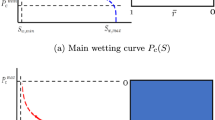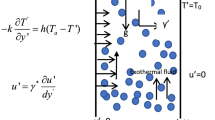Abstract
The present work compares the performance of two alternative flow models for the simulation of thermal-hydraulic coupled processes in low permeable porous media: non-isothermal Richards’ and two-phase flow concepts. Both models take vaporization processes into account: however, the Richards’ model neglects dynamic pressure variations and bulk flow of the gaseous phase. For the comparison of the two approaches first published, data from a laboratory experiment are studied involving thermally driven moisture flow in a partially saturated bentonite sample. Then a benchmark test of longer-term thermal-hydraulic behavior in the engineered barrier system of a geological nuclear waste repository is analyzed (DECOVALEX project). It was found that both models can be used to reproduce the vaporization process if the intrinsic permeability is relative high. However, when a thermal-hydraulic coupled problem has the same low intrinsic permeability, only the two-phase flow approach provides reasonable results.











Similar content being viewed by others
References
Alkan H, Müller W (2008) Approaches for modelling gas flow in clay formations as repository systems. Phys Chem Earth 33(Suppl 1):S260–S268
Alonso EE, Alcoverro J, Coste F et al (2005) The FEBEX benchmark test: case definition and comparison of modelling approaches. Int J Rock Mech Min Sci 42:611–638
Barr D, Birkholzer JT, Rutqvist J, Sonnenthal E (2004) Draft description for DECOVALEX-THMC Task D: long-term permeability/porosity changes in EDZ and near field, due to THM and THC processes in volcanic and crystalline-bentonite systems. Technical report, Earth Sciences Division, Lawrence Berkeley National Laboratory, USA
Börgesson L (1985) Water flow and swelling pressure in non-saturated bentonite-based clay barriers. Eng Geol 21:229–237
Börgesson L, Chijimatsu M, Fujita T, Nguyen TS, Rutqvist J, Jing L (2001) Thermo-hydro-mechanical characterization of a bentonite-based buffer material by laboratory tests and numerical back analyses. Int J Rock Mech Min Sci 38:95–104
Bruel D (2002) Impact of induced thermal stresses during circulation tests in an engineered fractured geothermal reservoir: example of the Soultzsous-Forets European hot fractured rock geothermal project, RhineGraben, France. Geothermics 57:459–470
Chijimatsu M, Börgesson L, Fujita T, Jussila P, Nguyen TS, Rutqvist J, Jing L (2009) Model development and calibration for the coupled thermal, hydraulic and mechanical phenomena of the bentonite. Environ Geol 57:1255–1261
Freiboth S, Class H, Helmig R, Graf T, Ehlers W, Schwarz V, Vrettos Ch (2009) A model for multiphase flow and transport in porous media including a phenomenological approach to account for deformation-a model concept and its validation within a code intercomparison study. Comput Geosci 13:281-300
Gens A, Alonso EE (1992) Framework for the behaviour of unsaturated expansive clays. Can Geotech J 29:1013–1032
Gou R, Dixon D (2006) Thermohydromechanical simulations of the natural cooling stage of the Tunnel Sealing Experiment. Eng Geol 85:313–331
Gray WG, Hassanizadeh SM (1991) Unsaturated flow theory including interfacial phenomena. Water Resour Res 27:1855–1963
Jang WY, Aral MM (2009) Multiphase flow fields in in-situ air sparging and its effect on remediation. Transp Porous Media 76:99–119
Kohl T, Evans KF, Hopkirk RJ, Rybach L (1995) Coupled hydraulic, thermal and mechanical considerations for the simulation of hot dry rock reservoirs. Geothermics 24:345–359
Kolditz O, Diersch H-J (1993) Quasi steady-state strategy for numerical simulation of geothermal circulation processes in hot dry rock fracture. Int J Non Linear Mech 28:467–481
Kolditz O, De Jonge JD (2004) Non-isothermal two-phase flow in low-permeable porous media. Comput Mech 33:345–364
Kuhn M, Bartels J, Iffland J (2002) Predicting reservoir property trends under heat exploitation: interaction between flow, heat transfer, transport, and chemical reactions in a deep aquifer at Stralsund, Germany. Geothermics 31:725–749
Lewis RW, Schrefler BA (1998) The finite element method in the static and dynamic deformation and consolidation of porous media, 2nd edn. Wiley, Chichester
Li Q, Wu Z, Bai Y, Yin X, Li X (2006) Thermo-hydro-mechanical modeling of CO2 sequestration system around fault environment. Pure Appl Geophys 163:2585–2593
Nguyen TS, Börgesson L, Chijimatsu M, Hernelind J, Jing L, Kobayashi A, Rutqvist J (2009) A case study on the influence of THM coupling on the near field safety of a spent fuel repository in sparsely fractured granite. Environ Geol 57:1239–1254
Olivella S, Gens A (2000) Vapour transport in low permeability unsaturated soils with capillary effects. Transp Porous Media 40:219–241
O’Sullivan MJ, Pruess K, Lippmann MJ (2001) State of the art of geothermal reservoir simulation. Geothermics 30:395–429
Philip JR, de Vries DA (1957) Moisture movement in porous materials under temperature gradient. Trans Am Geophys Union 38:222–232
Pruess K (2008) On CO2 fluid flow and heat transfer behavior in the subsurface, following leakage from a geologic storage reservoir. Environ Geol 54:1677–1686
Rutqvist J, Börgesson L, Chijimatsu M, Kobayashi A, Nguyen TS, Jing L, Noorishad J, Tsang CF (2001) Thermohydromechanics of partially saturated geological media—governing equations and formulation of four finite element models. Int J Rock Mech Min Sci 38:105–127
Rutqvist J, Wu Y-S, Tsang C-F, Bodvarsson G (2002) A modeling approach for analysis of coupled multiphase fluid flow, heat transfer, and deformation in fractured porous rock. Int J Rock Mech Min Sci 39:429-442
Rutqvist J, Barr D, Birkholzer JT, Chijimatsu M, Kolditz O, Liu Q, Oda Y, Wang W, Zhang C (2008) Results from an international simulation study on coupled thermal, hydrological, and mechanical processes near geological nuclear waste repositories. Nucl Technol 163:101–109
Rutqvist J, Barr D, Birkholzer JT, Fujisaki K, Kolditz O, Liu Q, Fujita T, Wang W, Zhang C (2009) A comparative simulation study of coupled THM processes and their effect on fractured rock permeability around nuclear waste repositories. Environ Geol 57:1347–1360
Sanavia L, Pesavento F, Schrefler BA (2006) Finite element analysis of non-isothermal multiphase geomaterials with application to strain localization simulation. Comput Mech 37:331–348
Schrefler BA, Matteazzi R, Gawin D, Wang X (2000) Two parallel computing methods for coupled thermohydromechanical problems. Comput Aided Civ Infrastruct Eng 15:176–188
Tsang C (1991) Coupled hydromechanical-thermochemical processes in rock fractures. Rev Geophys 29:537–551
van Genuchten MT (1980) A closed-form equation for predicting the hydraulic conductivity of unsaturated soils. Soil Sci Soc Am J 44:892–898
Villar MV, Fernandez AM, Cuevas J (1997) Caracterización Geoquímica de bentonita compactada: efectos producidos por flujo termohidráulico. Interim Report FEBEX, Informe 70-IMA-M-0-2, CIEMAT, Madrid
Wang W, Kosakowski G, Kolditz O (2009) A parallel finite element scheme for thermo-hydro-mechanical (THM) coupled problems in porous media. Comput Geosci 35:1631–1641
Zhang XY, Zhu YM, Fang CH (2009) The role for air flow in soil slope stability analysis. J Hydrodyn 21:640–646
Acknowledgments
The development of the numerical models was conducted in the framework of the international DECOVALEX project. The funding from the Federal Institute for Geosciences is highly acknowledged (Dr. Shao). This work is part of the PoF research initiative of the Helmholtz Association within the Environmental Engineering and Geothermal Technology programs. Funding from the Swedish Radiation Safety Authority (SSM) through the US Department of Energy Contract No. DE-AC02-05CH11231 is greatly appreciated.
Author information
Authors and Affiliations
Corresponding author
Rights and permissions
About this article
Cite this article
Wang, W., Rutqvist, J., Görke, UJ. et al. Non-isothermal flow in low permeable porous media: a comparison of Richards’ and two-phase flow approaches. Environ Earth Sci 62, 1197–1207 (2011). https://doi.org/10.1007/s12665-010-0608-1
Received:
Accepted:
Published:
Issue Date:
DOI: https://doi.org/10.1007/s12665-010-0608-1




